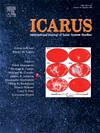Low thermal inertia of (162173) Ryugu a result of horizontal cracks in boulders
IF 2.5
2区 物理与天体物理
Q2 ASTRONOMY & ASTROPHYSICS
引用次数: 0
Abstract
Observations of the diurnal variations of the surface temperature of asteroid (162173) Ryugu from orbit and on the surface were performed by the Haybusa2 spacecraft and MASCOT lander. A low thermal inertia of the boulders on Ryugu was derived from these temperature variations and interpreted as the consequence of high porosity. Samples of Ryugu returned to Earth by Hayabusa2 showed higher thermal inertia when investigated by microscopic thermography. Here, we apply a simple thermal model, considering a horizontal fracture interrupting the heat flow into the surface, and investigate whether the low thermal inertia of Ryugu's boulders might be caused by fractures rather than high porosity. We find that the diurnal temperature variations on Ryugu observed by MARA can be partially explained by introducing a single horizontal crack at 9 mm depth below the surface observed by MARA.
Ryugu(162173)的低热惯性是巨石水平裂缝的结果
利用隼鸟2号和MASCOT着陆器对小行星(162173)Ryugu的轨道和表面温度的日变化进行了观测。琉球上巨石的低热惯性来源于这些温度变化,并被解释为高孔隙度的结果。由隼鸟2号返回地球的“龙宫”号样品在显微热成像研究中显示出更高的热惯性。在此,我们采用了一个简单的热模型,考虑到一条水平裂缝阻断了热流进入地表,并研究了Ryugu巨石的低热惯性是否可能是由裂缝而不是高孔隙率引起的。我们发现,在玛拉观测到的地表以下9 mm处引入一条水平裂缝可以部分解释龙宫的日温度变化。
本文章由计算机程序翻译,如有差异,请以英文原文为准。
求助全文
约1分钟内获得全文
求助全文
来源期刊

Icarus
地学天文-天文与天体物理
CiteScore
6.30
自引率
18.80%
发文量
356
审稿时长
2-4 weeks
期刊介绍:
Icarus is devoted to the publication of original contributions in the field of Solar System studies. Manuscripts reporting the results of new research - observational, experimental, or theoretical - concerning the astronomy, geology, meteorology, physics, chemistry, biology, and other scientific aspects of our Solar System or extrasolar systems are welcome. The journal generally does not publish papers devoted exclusively to the Sun, the Earth, celestial mechanics, meteoritics, or astrophysics. Icarus does not publish papers that provide "improved" versions of Bode''s law, or other numerical relations, without a sound physical basis. Icarus does not publish meeting announcements or general notices. Reviews, historical papers, and manuscripts describing spacecraft instrumentation may be considered, but only with prior approval of the editor. An entire issue of the journal is occasionally devoted to a single subject, usually arising from a conference on the same topic. The language of publication is English. American or British usage is accepted, but not a mixture of these.
 求助内容:
求助内容: 应助结果提醒方式:
应助结果提醒方式:


